As we are shuttered in, watching the world through a window, our appetite grows for finding the offline online; searching for a semblance of normality. Public access to arts and culture has always been paramount in the collective and individual understanding of our circumstances, of the world around us. During the current coronavirus pandemic, we act as generations have before: searching for solace and inspiration in troubled times.
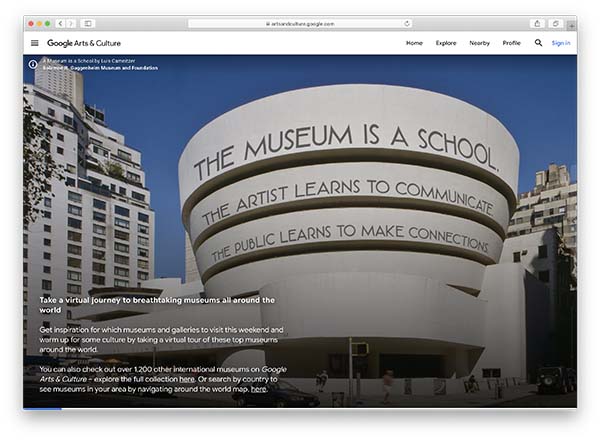
Take a virtual journey to iconic museums around the world with Google Arts & Culture; including New York’s Solomon R. Guggenheim Museum.
When closed off from friends, family and the rest of the world, this need grows stronger, and, unlike our predecessors, the digital world lets us maintain and even instigate these cultural conversations.
Leading the way in the digital culture sphere is Google. The decade-old Arts & Culture platform has taken on a new resonance in the current climate. With over 1,200 museums and galleries worldwide already signed up—and a specific app to complete the immersive experience—the Google Arts & Culture platform provides artistic sustenance to those locked inside.
From the Grandes Dames of art and culture such as the MoMA, Tate Britain and The Whitney, to more obscure niche centres—think the Museum of Brands, Amsterdam Street Art Museum or Mexico’s National Museum of Death—the platform allows the viewer to submerge themselves in a uniquely diverse cultural offering.
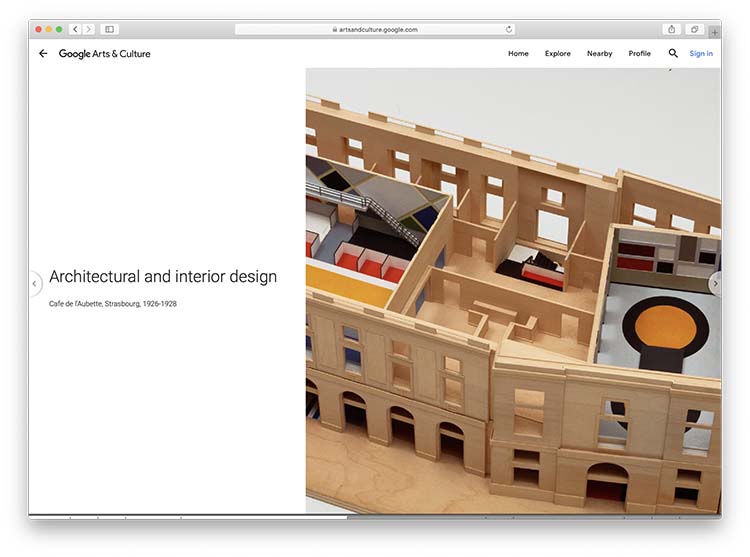
Visit the MoMA’s virtual Sophie Taeuber-Arp exhibition.
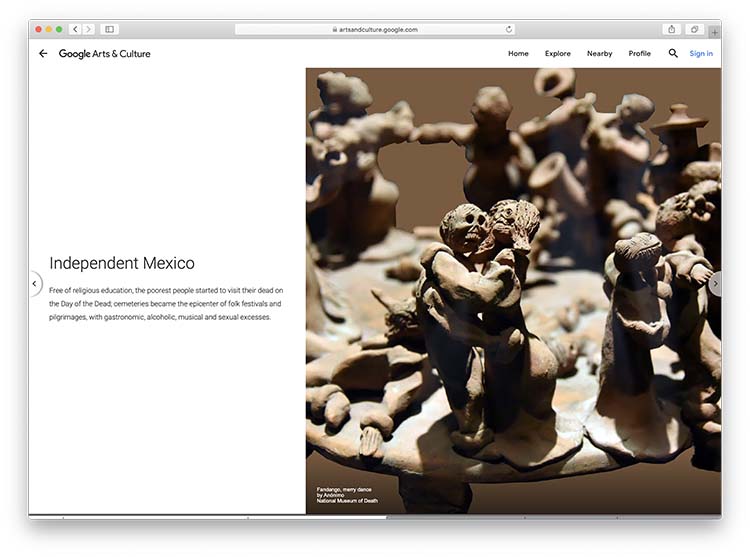
Discover Mexico’s National Museum of Death.
In more consequential news, The Sydney Biennale, due to take place this year, have taken their event online in light of the global crisis. Titled NIRIN, meaning ‘edge’ in Wiradjuri, this is an artist- and First Nations-led biennale showcasing more than 700 artworks by 101 artists and collectives, with a comprehensive 10-week online curation spanning channels from YouTube to Spotify.
The Biennale aims to create a global platform for diverse perspectives, creating dialogue and uniting people across the world; a sentiment shared by Google Arts & Culture itself, who will host artworks and virtual tours over the coming weeks. The platform allows us not just to explore collections we have never seen before or perhaps will never have the opportunity to visit, but also to connect with a wider community, to create a sense of global belonging by immersing ourselves in the art and expression of different nations, cultures, genders and identities worldwide.
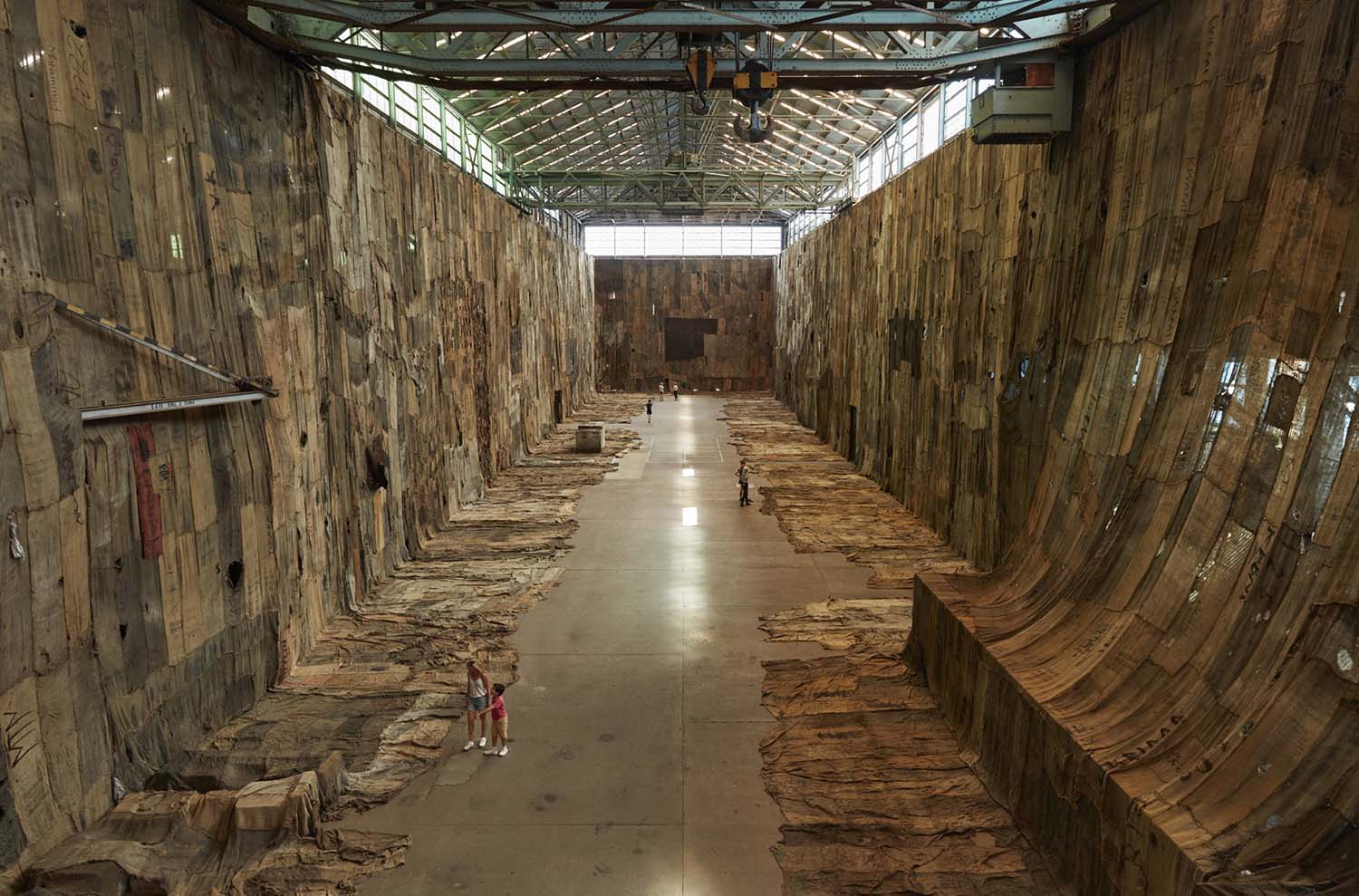
Ibrahim Mahama, No Friend but the Mountains 2012-2020, 2020,
Charcoal jute sacks, sacks, metal tags and scrap metal tarpaulin, dimensions variable.
Installation view (2020) for the 22nd Biennale of Sydney, Cockatoo Island.
Courtesy the artist; White Cube; and Apalazzo Gallery, Brescia. Photo, Zan Wimberley.
Away from the overarching presence of Google, many galleries are offering fully immersive exhibitions through 360° Virtual Reality-ready tours on platforms such as Artland and Eazel; allowing us to be present in temporary, permanent and even past exhibitions. Martin Asbæk Gallery in Copenhagen have taken their NEON group exhibition online, allowing virtual visitors to submerge themselves in a homage to this ubiquitous, yet uniquely confident medium.
Nottingham Contemporary allow online viewers to delve into the shows they may have missed with virtual viewing of temporary exhibitions from the past two years including the Turner prize winner Elizabeth Price’s Felt Tip installations; 50 years of the career of pioneering experimental filmmaker Liz Rhodes; and a retrospective of Linder, the radical feminist and post-punk artist who emerged from the Manchester scene of the 1970s. The virtual shows are presented by 3D tour producers, V21 Artspace.
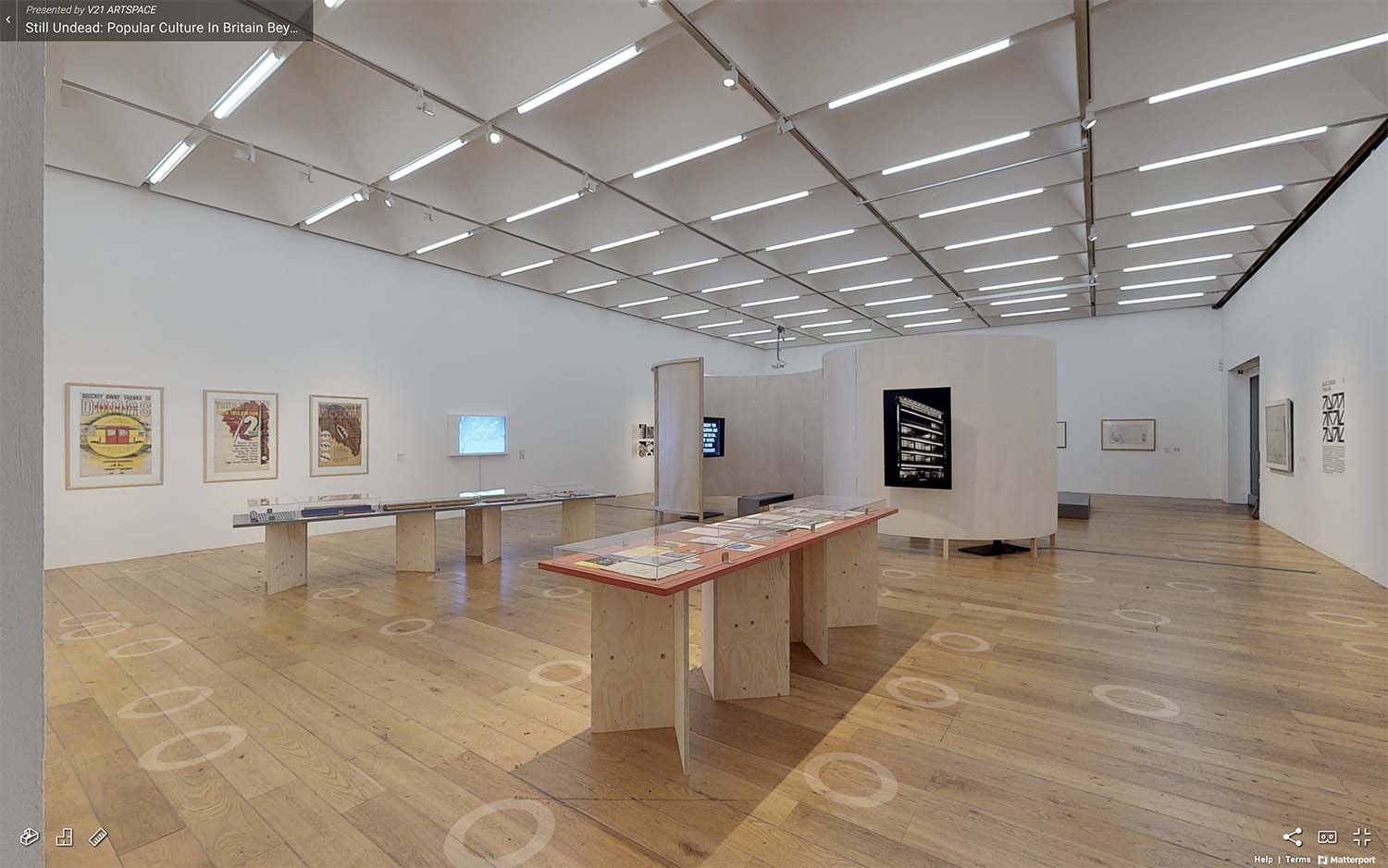
Still Undead: Popular Culture in Britain Beyond the Bauhaus at Nottingham Contemporary.
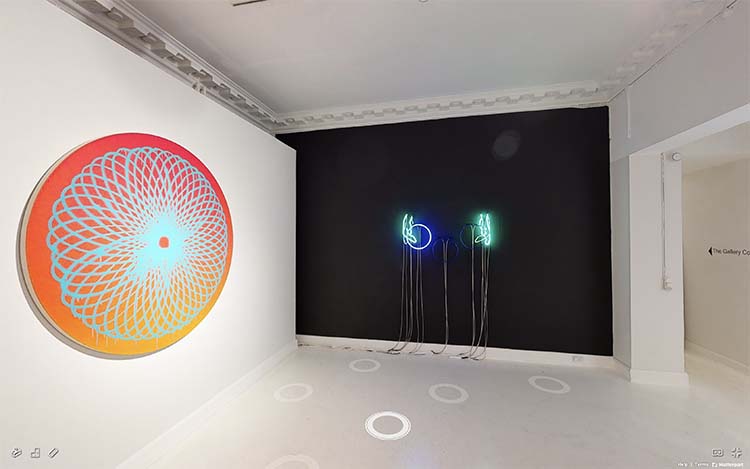
NEON group exhibition at Martin Asbæk Gallery, Copenhagen; as seen through Artland’s 360° virtual exhibition.
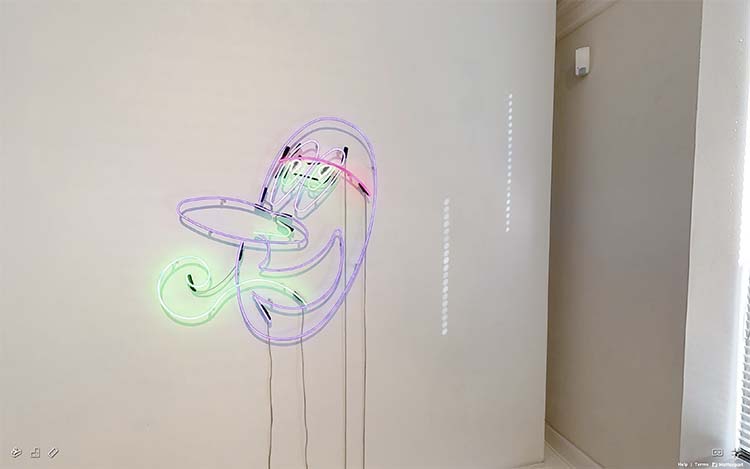
Other galleries are going one step further in inventing new ways of creating discussion and relationships in an online world. The Garage Museum of Contemporary Art in Moscow is offering not just a virtual visit but using this time of collective isolation to experiment and create new ways of interacting with art and audience, of cultivating unique voices and inventing new paths of connection.
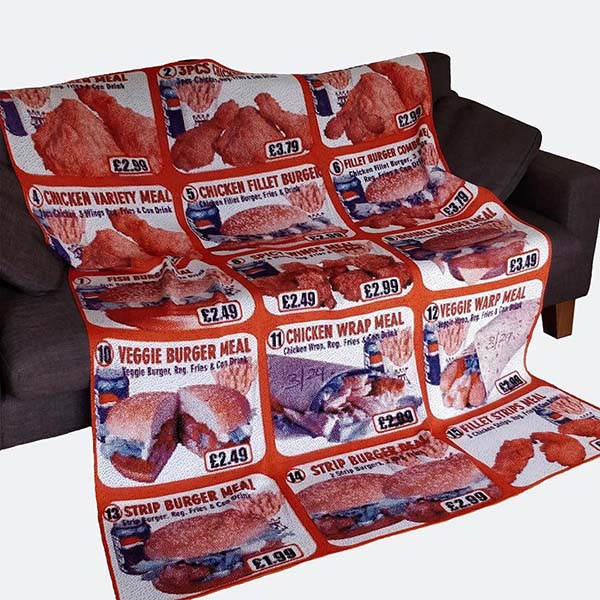
Sam Harris, Our Father who art in the chicken shop, wings be thy name. Part of Guts Gallery’s When Shit Hits the Fan Instagram exhibition.
Garage Digital is a fully immersive at home programme, from playlists to accompany virtual visits; IGTV videos of artists creating pieces with toilet paper and Tik Tok trash horror videos of the empty gallery space.
London’s Guts Gallery stays true to its founding vision of championing underrepresented contemporary voices—both artists and collectors—by holding their When Shit Hits the Fan exhibition on Instagram until 16 April. By curating this unique form of exhibition, Guts Gallery allows the community to like, comment and share in one space as would happen in a physical venue; breaking down our physical walls and transporting us into a digital public sphere. The social media event also includes the Guts Gallery Award, which will be voted on by the exhibiting artists, promoting mutual support and collaboration.
Keeping creatively connected during the many hours inside isn’t just limited to interacting with art galleries and spaces. The Artists in Quarantine instagram account, launched and curated by Giada Pellicari posts a work of art each day being created in the 12 Italian ‘confined red areas’; the most affected parts of the country. The featured artists riff on proximity, sex and love in self-isolating, claustrophobia and silence.
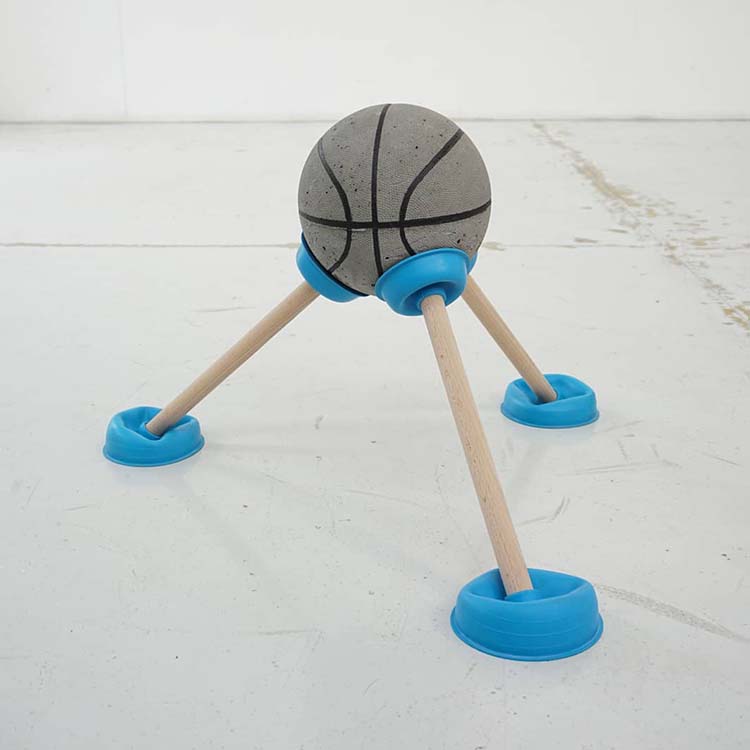
Antonio Guiotto, Chi perde lava I piatti; part of Artists in Quarantine. “During this quarantine period,” writes the project’s curator, Giada Pellicari, “this work seems to truly represent what we all are living. The time has been blocked, all of our games have been stuck. We are all waiting for our time to be starting again.”
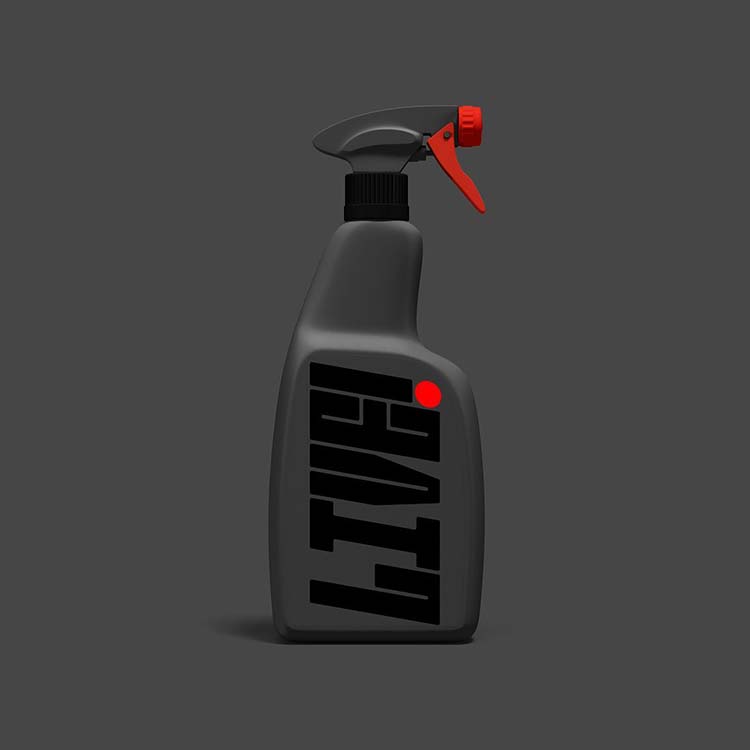
Hosted by Italian graphic designer Gianluca Alla, Live! is a series of live talks on Instagram with a focus on the creative industry.
In the design field, Italian graphic designer Gianluca Alla is hosting a new instagram project: Live!. Talks are streamed everyday at 5pm GMT with some of the biggest names in design and illustration today; think Anthony Burrill, Marco Oggian and Erik Kessels. The Social Distancing Festival also brings live streamed culture into our isolated lives, with a diverse programme from Opera at The Met to drag shows, comedy, theatre and spoken word poetry.
If getting your hands dirty is more your thing, Turner Prize-winner Grayson Perry has teamed up with Channel 4 to host an art show encouraging watchers to create their own art. ‘Grayson’s Art Club’ will feature lessons on drawing, painting and sculpting while motivating views to share their artworks of life on lockdown for a later exhibition documenting the impact of the coronavirus and a country in quarantine.
Learning about processes, thoughts and feelings outside of our own is not about taking the opportunity to shop online for the right pair of glasses to help us get through literature in lockdown, but it is the one chance to expand our horizons in ways we might not have ever imagined. We may not have this time ever again to venture beyond our preconceived attitudes to culture. We have been, up to this point in life, “too busy.” Not any more. It is now the time to immerse ourselves in other cultures and access another world we may not have ventured into before.
In art and culture we find a way to understand, emote, explore and process our emotions about a way of life alien to most of us. We may not yet be able to stand in a gallery and lose ourselves in brushstrokes dancing across a canvas. Not yet uncover an emerging artist, feeling a wave of new, as yet undefined emotions as we gaze on their work. Not yet see, touch and listen to artists and creators as they unveil new exhibitions. Yet, for now, we can be a part of a community outside the four walls of our homes, reach across countries and oceans and form a new, different, digital creative space.








